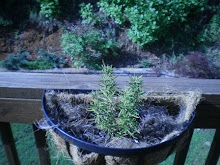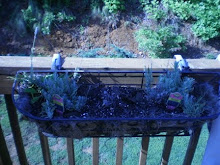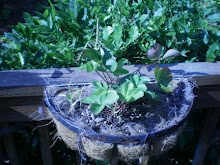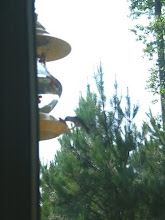Rosemary is a hardy, sun loving perennial shrub. There are two main varieties: an upright plant growing about 5 ft tall, with a stiff bushy appearance - suitable for hedges and a low-growing prostrate variety that is no higher than 12 inches. However, there are some other varieties of rosemary - one with white flowers and another with gold-edged leaves, these are rarely seen or used for culinary purposes.
Origin of this herb is native to the Mediterranean region and gets its botanical name from
ros (dew) and
marinus (sea), in reference to the areas around the Mediterranean where it grows abundantly.
Rosemary grows very well in sandy, well-drained soils and in misty sea-spray filled air.
Here is one legend I recently learned of while reading about my favorite herb, "Rosemary".
In first century AD, many legends surround rosemary, a herb that has been respected for all its virtues for thousands of years. This is one of the legends I found most interesting: It is that rosemary had plain white flowers until Mary, fleeing into Egypt with the Christ child, threw her blue robe over a rosemary bush while they rested beside it. The flowers then ceased to be white and turned forever into the blue color of her garment; since the herb has been referred to as "rose of Mary".
Rosemary leaves, when bruised, give off an aroma that is fragrant, pine-like, cooling, minty and refreshingly head clearing with hints of eucalyptus. The flavor is astringent, pine like, peppery, warming woody
and hereby, with a lingering camphor like aftertaste.
Compliments the following: Scones, dumplings and breads, pork, lamb and/or duck, mashed potatoes, soybeans, pate's and game, zucchini and eggplant.
Combines well with: ajowan, basil, bay leaves, coriander seed, garlic, marjoram, nutmeg, oregano, paprika, sage, savory, tarragon and thyme.
Rosemary twigs were also burnt as incense in the 17th century.English courtrooms to protect the court officials from diseases and jail fevers carried by the unfortunate prisoners. Hospitals would similarly burn rosemary and juniper, thereby preventing the spread of infections by sanitizing the air.
Still more to come on this fascinating herb......






























